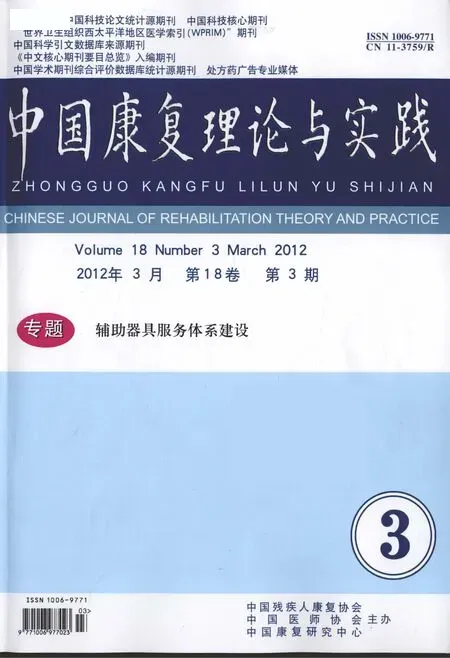运动、阿尔茨海默病与突触可塑性①
刘慧莉,赵刚
阿尔茨海默病(Alzheimer's disease,AD)是一种原发性神经退行性疾病。早期主要的临床表现为渐进性学习和记忆能力减退。全球65岁以上人群中约有6%的人罹患此病[1]。由于AD起病隐匿、病因复杂,目前尚无特效的治疗药物和手段,因此寻找经济有效的防治方法日益成为人们关注的焦点。
运动是中枢神经系统有效的刺激形式。所有运动都可向中枢神经系统提供感觉、运动和反射性传入,运动对大脑的功能重组和代偿起着重要作用。研究表明,运动不仅能提高普通人群的认知能力,还能减缓AD的发病和进展[2]。
突触(synapse)是神经元间相互接触部分的功能特化区,是神经元实现生理功能的关键部位。近年来,突触可塑性(synaptic plasticity)的研究引起人们关注。中枢神经系统的突触可塑性是研究学习和记忆神经机制的核心问题,突触可塑性改变可能是运动防治AD的细胞机制。本文综述运动对AD的防治作用、AD突触可塑性的改变及运动对突触可塑性的影响。
1 运动对AD的防治作用
1.1 流行病学调查 尽管在一项小样本调查中发现每周体力活动时间与AD发生的风险无关[3],但是,众多的研究证明,运动对AD有预防或改善的作用[4-6]。一项追踪调查表明,AD患者中年期很少活动,缺乏体力活动可使AD发病风险增加250%[5]。前瞻性研究也显示,体力活动能够对抗认知能力损害、AD和任何类型痴呆的进展,其中体力活动较多的人群,AD发生率下降60%[6]。
1.2 动物实验研究 在动物实验研究中,运动的防治效果与运动类型、运动强度、运动开始时间节点和运动持续时间有关。跑轮运动和跑台运动是干预啮齿类动物的两种最好的运动类型。
跑轮运动被认为是一种自愿运动方式,研究表明,与跑台运动相比,跑轮运动改善AD行为学和神经病理学损害更为有效[7]。跑轮运动对AD转基因小鼠的认知功能和病理过程的作用仍存在争议。跑轮运动减轻TgCRND8转基因小鼠β淀粉样蛋白(β-amyloid protein,Aβ)斑块沉积并且改善水迷宫学习能力[8];却没能改善APP23转基因小鼠空间学习能力、减少Aβ斑块沉积和增加海马神经再生[9]。这些矛盾的研究结果可能与转基因小鼠种类、跑轮运动开始的时间和运动持续时间有关。Richter等的研究表明,跑轮运动可能是转基因小鼠的一种固定行为[10]。
具有电刺激的跑台运动因为增加精神压力,对健康造成负面影响,被认为是一种强制运动。但也有研究发现,强制运动同样改善神经退行性疾病动物模型的认知功能[11-12];长期规律的跑台运动提高野生型小鼠和转基因小鼠水迷宫任务的学习和记忆能力[13-14]。此外,与单纯跑轮运动相比,丰富环境训练能更有效地改善AD转基因小鼠的认知功能损害,提示多种方式相结合的运动训练对AD的防治更有效[15]。
2 AD的突触可塑性改变
所谓突触可塑性是指突触在一定条件下,调整功能、改变形态及增减数目的能力;它既包括传递效能的变化,也包括形态结构的变化。中枢神经系统的突触可塑性是研究中枢神经系统生长、发育、蜕变、损伤修复以及在学习和记忆过程中神经机制的核心问题。研究表明,海马神经元的突触缺失和突触可塑性变化在老年性痴呆的病理过程中占据重要地位,可能是老年性痴呆学习和记忆功能障碍的神经生物学基础[16]。
长时程增强(long-term potentiation,LTP)是表现突触可塑性的重要电生理指标。已经证实,不同类型的AD转基因模型出现海马LTP减弱[17-18];AD转基因小鼠海马环路的突触传递异常早于Aβ沉积和神经细胞变性[19]。携带有突变APP695 SWE和PS1ΔE9基因的转基因小鼠,尽管空间学习能力下降,但离体海马脑片诱导的LTP却未发生变化[20]。先前的研究发现,突变基因APP695 SWE和PS1A246E过表达的17~18月龄的老年转基因小鼠,在体海马DG区LTP减弱,但离体海马脑片CA1区LTP不变[21]。此外,不同月龄(2、6、9和14月龄)的野生型小鼠和转基因小鼠离体脑片诱导的LTP未见不同[22]。这些研究的不同结论可能与实验方法(在体或离体)和研究通路不同有关。
突触蛋白(synapsin)可作为突触前终末的特异性标记物,用来检测突触的密度和分布。已发现AD患者脑海马结构内突触蛋白含量比正常人明显减少,提示AD患者的海马神经元突触密度下降[23-24]。Bertoni-Freddari早期研究发现,皮质和海马突触联系缺失的严重程度与AD的痴呆程度呈正相关[25]。Masliah等也发现,与AD临床症状的严重性关系最密切的是新皮质和海马中突触的缺失,而不是斑块负荷[26]。突触联系缺失在AD早期即可出现,以海马的齿状回分子层最严重[27],而在海马的其他区域和新皮质区程度较轻[28]。
3 运动对突触可塑性的作用
神经可塑性改变是神经损伤后恢复的基础。突触是神经可塑性变化的敏感部位,运动作为一种条件刺激,可引起突触形态结构和功能的重塑。
3.1 功能可塑性 电生理学研究发现,跑轮运动和跑台运动都能增强海马DG区的LTP[29-30]。4月龄Wistar大鼠连续跑台运动7 d后,在体记录海马DG区的LTP显著增强[31]。
运动对神经系统疾病的有益作用可能与突触传递效能的增强有关。运动训练使大脑中动脉缺血大鼠海马CA3区突触效应的习得性LTP形成速度明显快于安静对照组[32]。离体脑片电生理记录发现,匹鲁卡品所致的癫痫大鼠出现海马CA1区迟发型LTP减弱,运动训练可增强LTP[33]。马强等发现,8周跑轮运动明显减缓随后21 d慢性束缚应激对大鼠海马齿状回LTP的抑制,认为长期体力运动对海马有神经保护作用,可减缓慢性应激引起的损伤[34]。我们在先前的研究中也发现,长期规律的跑台运动改善8月龄AD转基因模型小鼠学习和记忆功能,同时伴有LTP增强[14]。
3.2 形态可塑性 突触的形态结构对突触功能状态和神经信息传递有重要影响,是学习和记忆能力的结构基础;促进突触形态可塑性的发挥,对AD的学习和记忆能力的改善具有重要意义。关于运动对突触形态可塑性影响的研究较少。大鼠进行8周游泳训练后,其大脑皮质运动区V层的大椎体细胞的胞体、核仁、树突棘密度均显著高于安静对照组,说明适宜运动对大脑皮质神经元的形态结构可能产生良好的影响,提高大脑对信息的处理能力[35]。关于运动影响突触形态可塑性的研究多集中于脑缺血康复治疗的实验研究中。Briones等发现,脑缺血损伤大鼠经过运动训练后,不仅增加海马齿状回的神经发生[36],同时促进齿状回突触形态可塑性的改变,表现为突触密度增加、多样性突触出现以及穿孔突触数量增加等[37-38]。右侧大脑中动脉缺血梗死模型大鼠进行多种方式运动训练,5周后透射电镜观察健侧大脑感觉运动皮质和海马CA3区突触结构发生可塑性变化,突触界面曲率、突触后致密物厚度和穿孔突触数量明显增加,改善了脑缺血大鼠学习和记忆功能[39]。
4 小结
突触的病理性重构是AD学习和记忆能力下降的病理基础之一;运动作为中枢神经系统最有效的刺激形式,对突触结构和功能的重组具有重要作用。采用不同运动方式、运动强度及运动开始干预的时间节点,研究运动对AD的防治效果以及运动防治AD的细胞机制具有重要意义。
运动对AD的干预是一个多机制的复杂过程,需要从行为学、电生理学、神经病理学、分子生物学等多个角度全面、深入地阐释运动防治AD的细胞和分子机制,为AD治疗的临床实践提供理论基础。
[1]Ferri CP,Prince M,Brayne C,et al.Global prevalence of dementia:a Delphi consensus study[J].Lancet,2005,366(9503):2112-2117.
[2]Um HS,Kang EB,Leem YH,et al.Exercise training acts as a therapeutic strategy for reduction of the pathogenic phenotypes for Alzheimer's disease in an NSE/APPsw-transgenic model[J].Int J Mol Med,2008,22(4):529-539.
[3]Wilson RS,Mendes De Leon CF,Barnes LL,et al.Participation in cognitively stimulating activities and risk of incident Alzheimer disease[J].JAMA,2002,287(6):742-748.
[4]Teri L,McCurry SM,Buchner DM,et al.Exercise and activity level in Alzheimer's disease:a potential treatment focus[J].J Rehabil Res Dev,1998,35(4):411-419.
[5]Friedland RP,Fritsch T,Smyth KA,et al.Patients with Alzheimer's disease have reduced activities in midlife compared with healthy control-group members[J].Proc Natl Acad Sci USA,2001,98:3440-3445.
[6]Laurin D,Verreault R,Lindsay J,et al.Physical activity and risk of cognitive impairment and dementia in elderly persons[J].Arch Neurol,2001,58:498-504.
[7]Yuede CM,Zimmerman SD,Dong H,et al.Effects of voluntary and forced exercise on plaque deposition,hippocampal volume,and behavior in the Tg2576 mouse model of Alzheimer's disease[J].Neurobiol Dis,2009,35(3):426-432.
[8]Adlard PA,Perreau VM,Pop V,et al.Voluntary exercise decreases amyloid load in a transgenic mouse model of Alzheimer's disease[J].J Neurosci,2005,25(17):4217-4221.
[9]Wolf SA,Kronenberg G,Lehmann K,et al.Cognitive and physical activity differently modulate disease progression in the amyloid precursor protein(APP)-23 model of Alzheimer's Disease[J].Biol Psychiatry,2006,60(12):1314-1323.
[10]Richter H,Ambrée O,Lewejohann L,et al.Wheel-running in a transgenic mouse model of Alzheimer's disease:protection or symptom?[J].Behav Brain Res,2008,190(1):74-84.
[11]Albeck DS,Sano K,Prewitt GE,et al.Mild forced treadmill exercise enhances spatial learning in the aged rat[J].Behav Brain Res,2006,168(2):345-348.
[12]Ang ET,Dawe GS,Wong PT,et al.Alterations in spatial learning and memory after forced exercise[J].Brain Res,2006,1113(1):186-193.
[13]Hoveida R,Alaei H,Oryan S,et al.Treadmill running improves spatial memory in an animal model of Alzheimer's disease[J].Behav Brain Res,2011,216(1):270-274.
[14]Liu HL,Zhao G,Cai K,et al.Treadmill exercise prevents decline in spatial learning and memory in APP/PS1 transgenic mice through improvement of hippocampal long-term potentiation[J].Behav Brain Res,2011,218(2):308-314.
[15]Mirochnic S,Wolf S,Staufenbiel M,et al.Age effects on the regulation of adult hippocampal neurogenesis by physical activity and environmental enrichment in the APP23 mouse model ofAlzheimerDisease [J].Hippocampus,2009,19(10):1008-1018.
[16]Redman S.The hippocampus,long-term potentiation and memory[J].Clin Exp Pharmacol Phychol,1996,23(10-11):961-964.
[17]Gengler S,Hamilton A,Holscher C.Synaptic plasticity in the hippocampus if a APP/PS1 mouse model of Alzheimer's disease is impaired in old but not young mice[J].PloS One,2010,5(3):e9764.
[18]McGowan E,Eriksen J,Hutton M.Adecade of modeling Alzheimer's disease in transgenic mice[J].Trends Genet,2006,22(5):281-289.
[19]Giacchino J,Criado JR,Games D,et al.In vivo synaptic transmission in young and aged amyloid precursor protein transgenic mice[J].Brain Res,2000,876(1-2):185-190.
[20]Volianskis A,Kostner R,Molgaard M,et al.Episodic memory deficits are not related to altered glutamatergic synaptic transmission and plasticity in the CA1 hippocampus of the APPswe/PS1DeltaE9-deleted transgenic mice model of beta-amyloidosis[J].NeurobiolAging,2010,31(7):1173-1187.
[21]Gureviciene I,Ikonen S,Gurevicius K,et al.Normal induction but accelerated decay of LTP in APP+PS1 transgenic mice[J].Neurobiol dis,2004,15(2):188-195.
[22]Fitzjohn SM,Kuenzi F,Morton RA,et al.A study of long-term potentiation in transgenic mice over-expressing mutant forms of both amyloid precursor protein and presenilin-1[J].Mol Brain,2010,3(1):21.
[23]Lippa CF.Synaptophysin immunoreactivity in Pick's disease:Comparison with Alzheimer's disease and dementia with Lewy bodies[J].Am J Alzheimers Dis Other Demen,2004,19(6):341-344.
[24]Guevara J,Dilhuydy H,Espinosa B,et al.Coexistence of reactive plasticity and neurodegeneration in Alzheimer's diseased brains[J].Histol Histopathol,2004,16(4):1075-1084.
[25]Bertoni-Freddari C,Fattoretti P,Casoli T,et al.Morphological adaptive response of the synaptic junctional zones in human dentate gyrus during aging and Alzheimer's disease[J].Brain Res,1990,517(1-2):69-75.
[26]Masliah E,Mallory M,Alford M,et al.Altered expression of synaptic proteins occurs early during progression of Alzheimer's disease[J].J Neurology,2001,56(l):127-129.
[27]Heinonen O,Soininen H,Sorvari H,et al.Loss of synaptophysin like immunoreactivity in the hippocampal formation is an early phenomenon in Alzheimer's disease[J].J Neuroscience,1995,64(2):375-384.
[28]Honer WG,Dickson DW,Gleeson J,et al.Regional synaptic pathology in Alzheimer's disease[J].J Neurobiol Aging,1992,13(3):375-382.
[29]Farmer J,Zhao X,Van Praag H,et al.Effects of voluntary exercise on synaptic plasticity and gene expression in the dentate gyrus of adult male Sprague-Dawley rats in vivo[J].Neuroscience,2004,124(1):717-719.
[30]Van Praag H,Christie BR,Sejnowski TJ,et al.Running enhances neurogenesis,learning,and long-term potentiation in mice[J].Proc NatlAcad Sci USA,1999,96(23):13427-13431.
[31]O'Callaghan RM,Ohle R,Kelly AM.The effects of forced exercise on hippocampal plasticity in the rat:a comparison of LTP,spatial-and non-spatial learning[J].Behav Brain Res,2007,176(2):362-366.
[32]余茜,李晓红,吴士明,等.运动康复对脑梗死大鼠学习记忆能力和LTP的影响[J].中华物理医学与康复杂志,2002,24(3):140-143.
[33]Arida RM,Sanabria ER,da Silva AC,et al.Physical training reverts hippocampal electrophysiological changes in rats submitted to the pilocarpine model of epilepsy[J].Physiol Behav,2004,83(1):165-171.
[34]马强,王静,刘洪涛,等.体力活动减缓慢性应激对海马的损伤作用[J].生理学报,2002,54(5):427-430.
[35]白石,刘涛,赵晓慧.不同负荷游泳训练对大鼠大脑皮质形态学影响的实验研究[J].中国运动医学杂志,2003,22(5):474-478.
[36]Briones TL,Suh E,Hattar H,et al.Dentate gyrus neurogenesis after cerebral ischemia and behavioral training[J].Biol Res Nurs,2005,6(3):167-169.
[37]Briones TL,Suh E,Jozsa L,et al.Changes in number of synapses and mitochondria in presynaptic terminals in the dentate gyrus following cerebral ischemia and rehabilitation training[J].Brain Res,2005,1033(1):51-57.
[38]Briones TL,Suh E,Jozsa L,et al.Behaviorally-induced ultrastructural plasticity in the hippocampal region after cerebral ischemia[J].Brain Res,2004,997(2):137-146.
[39]余茜,李晓红,吴士明.运动训练后脑缺血大鼠学习记忆与健侧脑内突触结构变化的关系[J].中华物理医学与康复杂志,2002,24(7):399-402.

